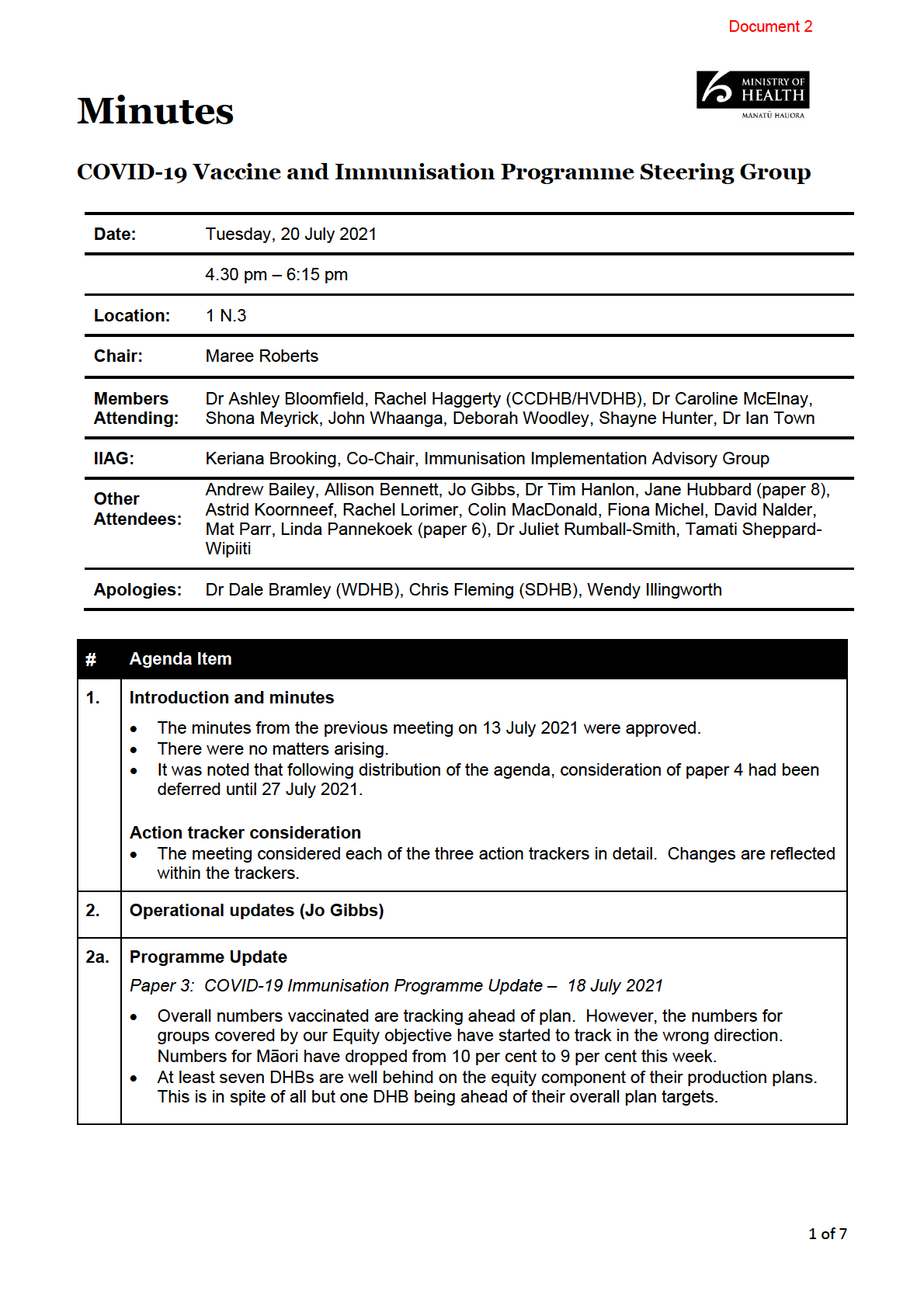
1982
ACT
INFORMATION
OFFICIAL
THE
UNDER
RELEASED
Document 2
2b. Process to identify operational impacts of policy proposals
• IIAG members have been receiving papers that including a line ‘we wil assess
operational implications”. IIAG noted some queries and cautions about papers being
submit ed, potentially for approval, when operational implications were not identified.
• Suggestions included clarifying the level at which operational implications would be
identified (i.e. provider), who would do the assessment and by when, and how would the
Steering Group know when the stated assessment has been completed. What would be
the process to manage impacts of implementation was already completed? Who had the
systems impact overview?
Group discussion
• Agreed that where the operational implications of paper should ideally by assessed and
understood prior to consideration, or they should signal why the assessment had not yet
been done.
1982
Action 1: implement a mandatory cover sheet for papers to Steering Group which:
•
Includes a list of the groups or stakeholders involved in development
of/consultation on the paper;
ACT
•
States whether an assessment of operational impacts has been made; and
•
States whether an assessment of the contribution the proposals wil make
towards achieving the equity objectives has been made.
3.
Standing item on Science and Technical – CV-TAG (Dr Ian Town)
Verbal updates were provided
:
•
Myocarditis: The CV-TAG has had its third and final meeting to discuss events of
myocarditis/pericarditis post-vaccination, and related matters. Formal advice wil be
INFORMATION
provided to the Director-General on 21 July 2021.
• Pacific Islands nations using the Pfizer vaccine have sought advice about myocarditis
associated with use of this vaccine in younger males, and also the forthcoming advice
about use in 12-15 year olds.
4.
Risk update (David Nalder)
OFFICIAL
Paper 5: CVIP Programme risk summary for Steering Group – 20 July 2021
• The ‘ultimate’ risks of the project ar
THE e:
o Loss of public confidence,
o Lack of equity of access,
o Low uptake.
• A workshop earlier the same day has themed up the emerging programme risks:
UNDER
o Expectation management,
o Reducing complexity,
o Legacy and transition.
• A further round of risk profile scoring wil be held later in the week.
• Will continue to work with delivery leads on an ongoing basis to ensure risks to the
implementation are identified, assessed and managed appropriately.
• As we move into the Assurance Framework, the focus wil be the controls around how key
RELEASED
risks are addressed.
Group discussion
• A question was asked as to performance risks such as those impacting on achieving
equity. While there are many strands to this reporting, it can be hard to get a feel for
overall performance and to risks at this level.
(Cont. over)
• It was noted that generally this would be picked up through assessment against the four
dimensions in the Success Framework. Equity was one of these dimensions.
2 of 7
Document 2
• It was agreed that the point at which cumulative risk is such that it impacts on the
‘ultimate’ risk was not clear.
Action 2: Apply the Balanced Scorecard as a reporting tool to help show the overall
picture of performance. Timeframe – from next Steering Group meeting 27 July 2021.
Decisions of the Steering Group
In relation to paper
5 – CVIP Programme risk summary for Steering Group – 20 July 2021,
the Steering Group:
a) Noted the map of inherent risks across the end to end vaccination process design;
b) Agreed that lack of ability to gain early warning of threats to overall performance was
a risk;
c) Noted the actions in place to manage and these top risks; and
d) Agreed to
implement the Balanced Scorecard as a reporting tool to help show the
1982
overall picture of performance.
5.
Population Data Decision (Linda Pannekoek)
ACT
Paper 6: Denominator data for vaccine uptake monitoring – 20 July 2021
• CVIP is recommending adopting Health Service Utilisation (HSU) data to use as a
denominator for monitoring vaccination uptake.
• Historically, the Ministry has used Estimated Population projections from the Census data
as the denominator against which health statistics are compared
• There are acknowledged differences between this and actual health use data, this is
primarily related to the ethnicity recorded in each dataset
INFORMATION
• The HSU population database has recently been finalised and is ready for use. It is
based on numbers enrolled in PHOs and other health service use e.g. fil ed prescriptions,
hospital care).
• CVIP wants to be able to publish rates of vaccine uptake for various population groups.
• If agreed, this would be implemented promptly.
OFFICIAL
Group discussion
• CVIP initial data collection re vacc
THE ine use has been against the Census. Any reporting
against this wil need associated communications about denominator, including its
limitations.
• The Census contains a larger proportion of Māori than does the HSU (by about 1.3%).
Care is needed to ensure it is clear that we are trying to present the most accurate data
UNDER
we can about access to vaccine.
• Other parts of the Ministry are also interested in the results of any implementation by
CVIP. Potential opportunity to update the quality of data in the wider system.
Decisions of the Steering Group
In relation to paper 6,
Denominator data for vaccine uptake monitoring – 20 July 2021, the
Steering Group:
RELEASED
a) Agreed that the CVIP Programme will use the Health Service Utilisation population as
the denominator for COVID-19 vaccine uptake monitoring purposes.
3 of 7
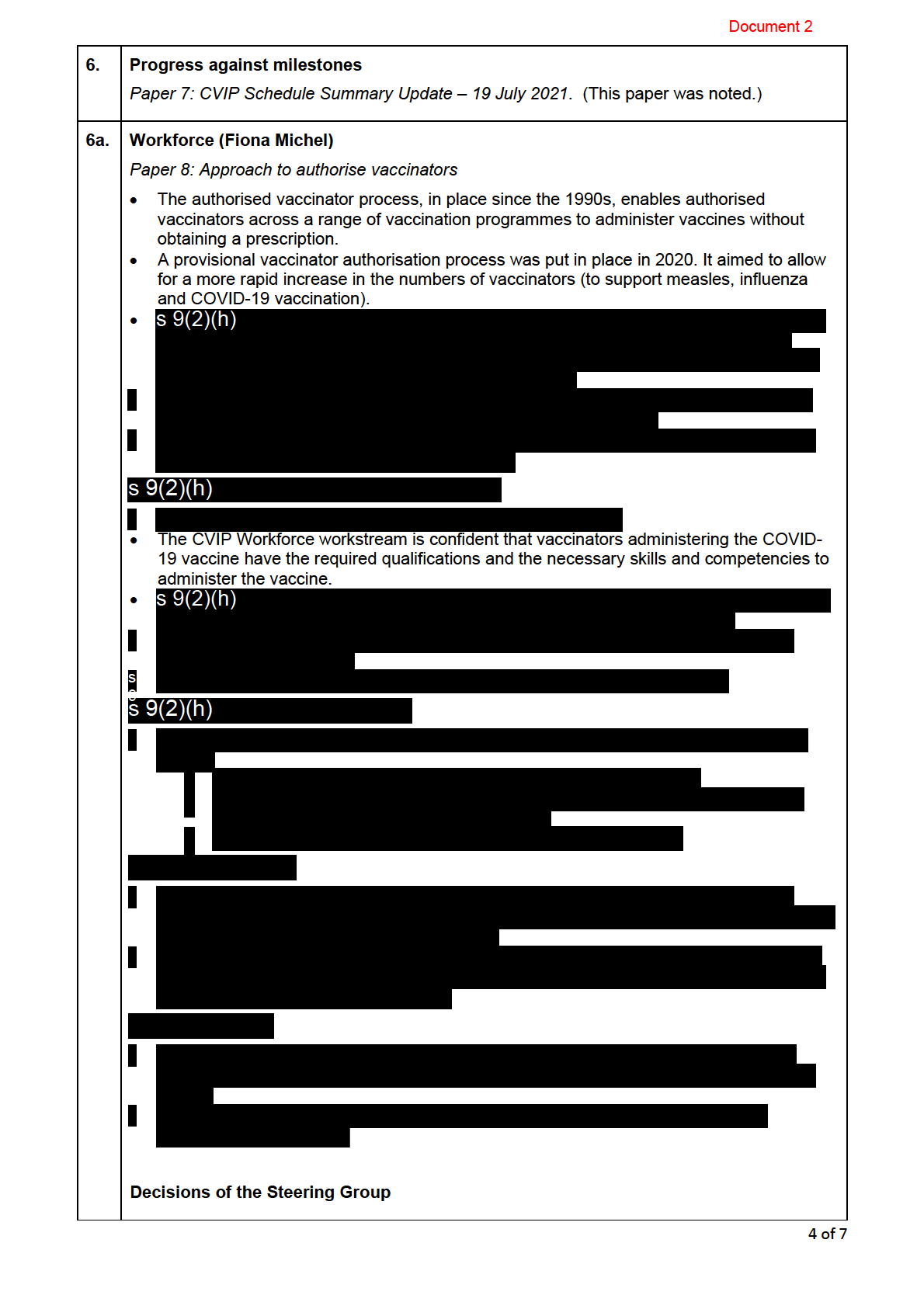
1982
ACT
INFORMATION
OFFICIAL
THE
UNDER
RELEASED
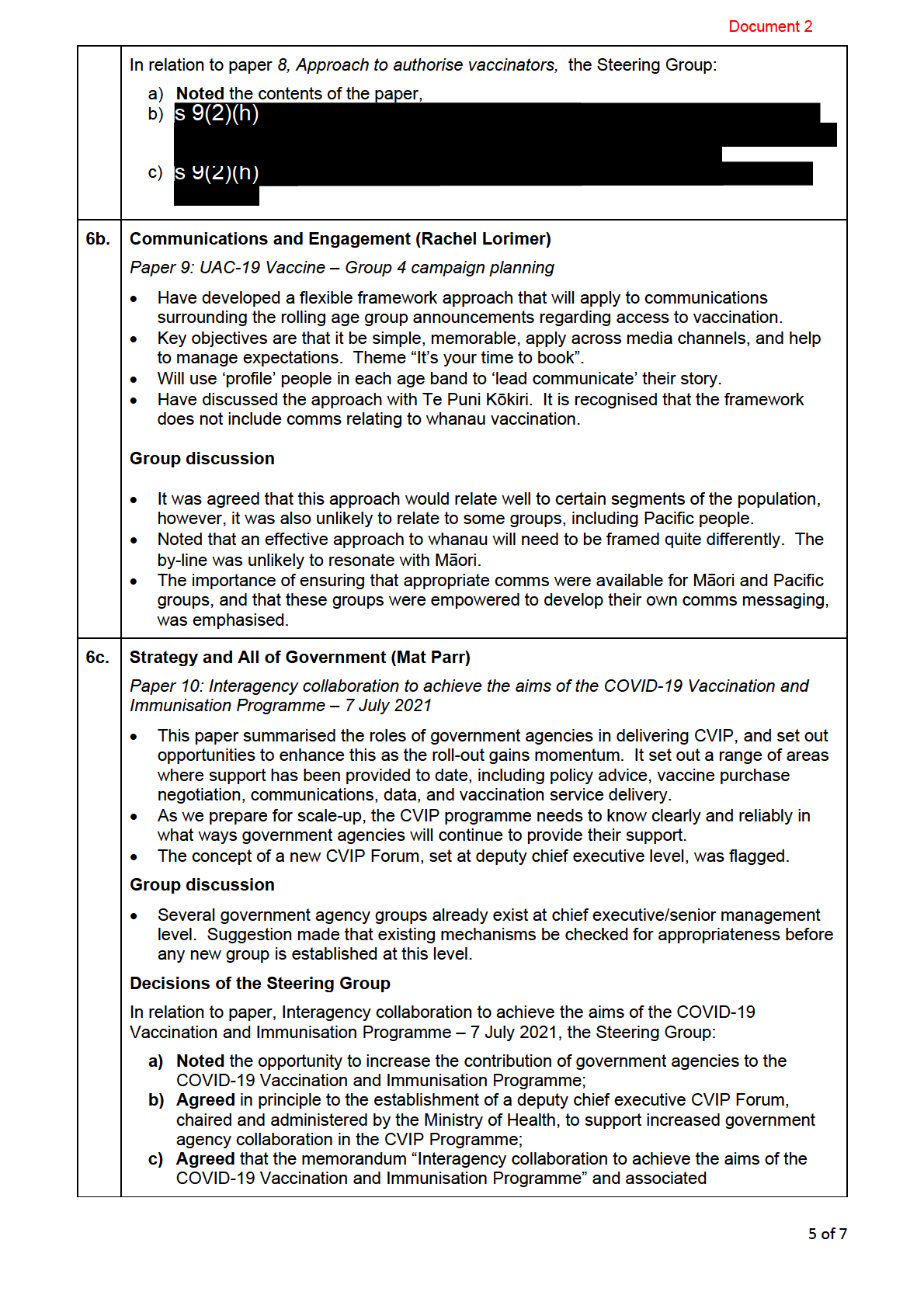
1982
ACT
INFORMATION
OFFICIAL
THE
UNDER
RELEASED
Document 2
recommendations be shared with the public sector COVID-19 Board, led by DPMC, for
endorsement;
d)
Agreed that the memorandum “Interagency collaboration to achieve the aims of the
COVID-19 Vaccination and Immunisation Programme” may be shared with other
agencies for discussion; and
e)
Endorsed that existing chief executive/senior management level groups should be
checked for appropriateness before any new group is established to support increased
government agency collaboration in the CVIP Programme.
6c. Equity (Tamati Sheppard-Wipiiti)
Paper 11: Five Point Plan to Disability Action Plan
• We are moving focus from enabling providers to monitoring DHBs. Have agreed
performance targets. However some issues are emerging.
1982
• Have talked to most of the DHBs about their approach to ensuring the access to and
delivery of vaccination services for members of the disability community. A multi-pronged
approach is under way:
ACT
o Leadership: use a profile personality to spearhead public engagement, potentially
Hon Carmel Sepuloni (Minister for Disability Issues).
o Disability communications fund: EOIs have now been received from parties
engaging with the disability community. We expect to negotiate with/fund about 80
per cent of those who applied.
o Invitation and accommodations: the national call centre wil be able to include site
accommodations required to support clients during their vaccination.
o Supported decision-making: guidance has been developed however does not
appear to be being followed uniformly. IMAC wil host a seminar for the sector to
build awareness.
INFORMATION
o Increasing provider flexibility: The Ministry of Social Development has confirmed it is
providing flexibility within its own contracting with social services providers to allow
them to better focus on vaccination roll-out. However, this message needs to now
reach the disability community.
• The lack of robust disability data is a recognised national issue. We need to focus on
data relating to COVID-19 vaccination roll-out.
OFFICIAL
Group discussion
• Limitations of having only two week
THE s’ reporting were noted.
• Cautioned that the problem for disability and more widely across equity, was not planning
but delivering. We need to ensure that people are accountable for their delivery.
• Delivering for equity outcomes means creating the right environment – relieving some
current non-COVID-19 vaccination services – ensuring providers have vaccine supply
• Noted that using DHBs al
UNDER one wil not achieve the provider diversity required to achieve
equity objectives.
• Important to both low intensity/high yield AND high intensity/low yield effort concurrently to
achieve the desired results. The contribution of primary care sector vaccination is
extremely important.
Action 2: Schedule a discussion on Equity as a key agenda item for next meeting.
Discussion to include a rethink of the comms, the plan and the overall approach.
RELEASED
6d. Clinical Safety and Quality (Dr Juliet Rumball-Smith)
Paper 12 – Early Second Dose – Identified issue and action plan
• Following the signal at last week’s meeting, we have worked with DHBs and identified that
about 1,270 people have received their second COVID-19 vaccine prior to 21 days after
their first dose.
• This is action is considered off-label, or unapproved. A CARM and incident report must
be completed for these cases.
6 of 7
Document 2
• We are taking steps to ensure DHBs are aware of and implement the 21-day requirement
on every occasion:
o Technical response – current second booking settings in the booking system and
in CIR are considered robust. The booking system does not allow for early second
booking. An additional ‘early vaccine warning’ box is being added to the CIR,
effective early August.
o We are actively engaging with DHB CEOs, clinical leads and quality leads to
remind them of the need to ensure the second COVID-19 vaccine dose is
administered no earlier than 21-days after the first.
• An action plan sets out the engagement completed and actions planned (including
ongoing weekly reports to DHBs and other vaccination service providers) to ensure
requirements relating to the first/second dose interval are met.
Other safety and quality issues discussed
• Mass vaccination events wil need careful quality management oversight because of the
1982
volumes being handled.
• Some ‘division of tasks’ appears to be occurring now in some situations (e.g. drawing up
multiple vaccines at a time) which could be contributing to current quality issues and
ACT could
also transfer into mass event situations.
• Some issues may simply be data issues and need to be checked. For example, some
incorrect expiry information has been identified in CIR.
Decisions of the Steering Group
In relation to discussions about paper
Early Second Dose – Identified issue and action plan
Dose and related quality issues, the Steering Group:
a)
Noted the contents of the paper
Early Second Dose – Identified issue and action plan,
b)
Noted that several other areas were under consideration from a quality improvement
INFORMATION
perspective, and
c)
Requested that a paper be prepared for the Minister setting out the information on the
quality improvement issues identified for CVIP and the actions being taken to address
these.
Action 3: draft Health report setting out the information on the quality improvement
issues identified for CVIP and the actions being taken to address these. (Dr Juliet
OFFICIAL
Rumball-Smith)
7.
Any other business
THE
The following papers were noted:
• Paper 13 – Communications and engagement support for COVID-19 vaccine rollout
• Paper 14 – Readiness update – confirmation of progress on outstanding items
• Paper 15 – COVID-19 vac
UNDER cine roll-out - International comparisons
• Paper 16 – Workplace (vaccination) EOI update
• Paper 17 – Update on vaccine delivery to Tokelau.
8.
Next Meeting
Tuesday 27 July 2021, 4.30 p.m. – 6.00 p.m.
RELEASED
7 of 7

1982
ACT
INFORMATION
OFFICIAL
THE
UNDER
RELEASED
Document 2
either received their invitation through sequencing, or been vaccinated through Group 2
arrangements.
• The event wil provide valuable learnings for future events as we scale up.
2b. Reporting against the Success Framework
Paper 4 tabled – COVID-19 Immunisation Programme Success Framework
• The four principles against which the success of the programme wil be measured have
been agreed by Cabinet (efficiency, equity, safety, experience).
• This table is an early effort. It starts to populate the success framework with actual data.
It wil be updated to the Steering Group every fortnight.
• Following the recent decision of the Minister for COVID-19, the denominator data used
wil be from the HSU rather than NHI. Data can be accessed at DHB level, by dose and
overlaid by e.g. age band, ethnicity etc.
1982
• This reporting applies only to Group 4 data going forwards.
Group discussion
ACT
• IIAG members noted that given the Government commitment towards certain groups, and
to then apply age bands in a certain way, the programme needs to be able to present this
information clearly.
• A question for the future was to understand the point at which it is understood from the
data that there is a problem with any given district.
• The potential to help to portray booking capacity was noted.
Action 1: Ministry to run a split of forward bookings by age band and ethnicity (with a
particular focus on young people, including those aged under 16 years).
3.
Immunisation Implementation Advisory Group update (Keriana Brooking/T
INFORMATION
e Puea
Winiata)
• The key issues discussed at the IIAG meeting on 22 July were largely on the agenda for
the meeting and could be picked up in detail then:
o Delivering for equity: specifically DHB delivery against their respective production
plans. Noted that these plans do not take into account the cumulative effort made by
OFFICIAL
some DHBs right from the start.
o Disability: I AG members had a long discussion about work being done in the
disability space, noting with so
THE me concern that this is some way off the work done to
help meet the needs of Māori and Pacific peoples.
o Access to vaccination: noted the intention is to push harder into primary care to
improve uptake in September/October. However there seems to be a variable
approach to commissioning completion and it was felt that not all DHBs would be able
to confirm primary care
UNDER sector readiness.
o There is a preference from some older Group 3 people to be vaccinated at primary
care rather than at mass events.
o Impact of environmental issues on CVIP delivery - e.g. tired workforce.
• Concerns were also expressed that increases in the rates of pay for those providing
COVID-19 vaccination had flow-on impacts for other vaccination services. In particular
these rates may now be higher than rates paid for influenza vaccination. This has
implications
RELEASED for the COVID-19 workforce.
General discussion
• Ministry of icials indicated that at a national level the rates paid to influenza vaccinators
were not lower than the rates for COVID-19 vaccinators. However, some providers have
some pricing flexibility; the Ministry has little control over this. IIAG representatives were
invited to contact Jo Gibbs if they wished to explore this further.
2
Document 2
• Noted that the Steering Group needed a mechanism to ensure it does not lose sight of
issued raised by IIAG and to ensure their resolution.
Action 2 : Steering Group is to consider actions from future IIAG meetings in the same
way as for other groups.
• IIAG Members also reiterated a concern they had raised at their meeting on 22 July, being
that the operational implications of policy proposals coming to the Steering Group often
have not been scoped. This impacts on the ability of the Steering Group to make
informed decisions.
Action 3 : The need to ensure operational implications of policy proposals are
assessed is to be discussed at the Programme Leadership Group meeting, and those
presenting papers to the Steering Group must use the recently developed cover sheet.
1982
4.
Equity (Jason Moses)
ACT
4a. Paper 5 – Monitoring equity production plans
• Whilst DHBs are broadly meeting wider targets, overall they are performing at 59 per cent
of their production plans for Maori.
• Noted that delivery to Pacific people is well on track.
Group discussion
• We are now three weeks into Group 4 roll-out. Early performance signals for Māori in
particular should be regarded as a red risk flag. The Steering Group did not accept some
of the reasons for poor performance provided by DHBs.
INFORMATION
• The Ministry has done significant work with DHBs to develop their equity production plans.
It is reasonable to hold DHBs accountable for the delivery.
• In spite of the overall result, some DHBs have delivered to their plans, including Māori in
the age sequencing bands. They are keen to commence vaccinating younger Māori,
rather than wait for further age band announcements.
• Consideration would be given to asking Vaccine M
OFFICIAL inisters to revisit their decisions to allow
scope in operational delivery, delegated to the Ministry of Health
Decisions of the Steering Group
THE
In relation to paper 5
– Monitoring equity production plans – 27 July 2021, the Steering
Group:
a) Noted that early indications are that overall, DHBs are not achieving their agreed
equity targets;
UNDER
b) Agreed that a paper on the plan to improve equity results will be prepared for
consideration by Vaccine Ministers at their meeting on 30 July 2021. This paper must
take a public health approach and include:
• the proportion of under 65 year old population (Māori, non-Māori, Pacific, non-
Pacific) who have been vaccinated to date;
• discussion on the impact of lowering age bands;
• bespoke actions for each under-performing DHB, understanding their specific
RELEASED barriers; and
• discussion on how DHBs that are performing well against their equity
performance plans would be able to begin vaccinating younger age groups
(with an equity focus) out of sequencing.
c) Agreed that this matter wil be discussed with Vaccine Ministers at their meeting on
30 July 2021.
3

1982
ACT
INFORMATION
OFFICIAL
THE
UNDER
RELEASED
Document 2
• CV-TAG recommends that people aged 16-29 years receive their second dose of Pfizer at
least eight weeks after the first dose.
• People aged 16-29 years who require regular clinical review by a cardiologist should
discuss their COVID-19 vaccination situation with their healthcare professional.
• Anyone who develops myocarditis and/or pericarditis after their first Pfizer vaccination
should not receive a second dose.
• CV-TAG wil continue to monitor this situation and provide advice as evidence becomes
available.
(Use of Pfizer for those aged 12-15 years – Appendix 2 of Paper 6)
• This advice is provided within New Zealand’s very low prevalence context.
• There is relatively limited amount of data from trial, and limited experience internationally,
about vaccination of children.
• Generally, children have a lower risk of poor health outcomes from COVID-19 infection.
1982
• There is a safety signal out about myocarditis in people aged under 30 years receiving
mRNA vaccines (such as Pfizer);
ACT
• There is no urgent need to move to vaccinating those aged 12-15 years. Consideration
can be given to including vaccination of people in this age group if they are high risk.
• CV-TAG wil review this situation once it has received expected advice from an external
specialist.
Equity
• The paper contemplates several matters that have implications for the achievement of the
desired equity results. For example, not extending the use of Pfizer to 12-15 year olds
now may impact on uptake for those who might access the vaccine through whānau-
INFORMATION
based approaches this year.
5c. Views of the Regulator (Medsafe)
Verbal update – Medsafe regulatory update on the safety signal of myocarditis with Comirnaty
(Pfizer COVID-19 vaccine)
OFFICIAL
• The Medsafe information in Paper 6 outlines its regulatory work in this area as well as the
expert advice received along the way.
• Medsafe’s regulatory view is the dat
THE a currently available internationally indicates that
there is a rarely-reported side effect of myocarditis associated with Pfizer vaccine. The
data reported in New Zealand does not currently confirm this signal or if there is a higher
risk in under 30s in New Zealand, however, numbers are small so care needs to be taken
with interpretation.
• From a regulatory perspec
UNDER tive, Medsafe considers the benefits of vaccination with the
Pfizer vaccine outweighs the risks as per the approved indication and dosing.
• The emerging data shows the pharmacovigilance system is working well and this issue is
an example of what is to be expected when identifying rare adverse reactions that clinical
trials would be too small to pick up. The key regulatory objective is to ensure product
information is updated and communicated to give consumers and health care
professionals information.
• Medsafe has regularly discussed this issue with international regulators and is in line with
RELEASED
international colleagues, including Australia. All regulators have added, or are about to
add, information to the approved product information (datasheet). The New Zealand
update is likely to be published shortly. The planned addition to the datasheet aligns with
the communication Medsafe published last week. This was done to provide information to
healthcare professionals on this rare side effect reported and what to look for. Noted there
was little to no media follow up to Medsafe’s alert.
• Regulators are not currently planning to take any other action such as making changes to
approved indication or dosing. They maintain regular contact and wil continue to update.
5
Document 2
• Medsafe wil continue to monitor this issue as new data becomes available and continue
to get expert advice on the clinical significance and benefit risk balance of the vaccine in
the approved indication.
Verbal update - Age range change for Comirnaty for 12-15 year olds (Pfizer vaccine)
• Pfizer applied for the indication to be extended to 12 years and over and submitted clinical
trial data in support of that. Medsafe assessed that information against internationally
agreed criteria and approved the extension of the indication.
• The age range was also approved last week (week commencing 19 July 2021) in
Australia. It has also been approved in other nations including the EU, the USA and
Singapore.
5d. Group discussion on Paper 6
1982
• It was observed that there was a close interrelationship between decisions regarding the
incidence of myocarditis/pericarditis, and proposals relating to the time lapse between
doses.
ACT
• Noted that few jurisdictions are vaccinating those aged 12-15 years.
• Based on current roll-out plans delivery to those aged under 30 years by the end of the
year would be challenging.
• Noted there is a difference between the programme view and the regulatory view.
• Following its concerns raised earlier, the IIAG asked if this paper should have been
provided to the Group for prior consultation noting operational implications of some
aspects.
• The Director-General and the regulator noted that there was a delineation between
regulatory decisions and programme decisions. Much of the advice provided in this paper
was of a regulatory or technical nature (i.e. from the Regulator and CV-TAG)
INFORMATION .
5e. Steering Group decisions – Paper 6
In relation to Paper 6 – Consideration of the risk of myocarditis and pericarditis, advice on the
Pfizer COVID-19 vaccine for children and use of the Janssen vaccine, the Steering Group:
a) Noted that CV-TAG has provided its recommendations on the risk of myocarditis and
OFFICIAL
pericarditis in those aged under 30 years following vaccination with the Pfizer
vaccine;
b) Noted the perspectives of the Regulator in relation to myocarditis associated with the
THE
Pfizer vaccine, and in relation to use of the Pfizer vaccine on those aged 12-15 years;
c) Noted that there are dif erences between the regulatory view and the proposals for
programme delivery;
d) Noted the need to maintain public confidence in COVID-19 vaccination; and
e) Agreed that the issues raised in Paper 6 and their potential impacts will be further
UNDER
considered and a decision taken offline.
6.
Risk update (David Nalder)
Paper 7: CVIP Programme risk summary for Steering Group – 27 July 2021
• The risk profile has not changed. The higher project risks remain:
o Embeddi
RELEASED ng equity
o Invitation and booking system
o Legislative and regulatory compliance
o Managing complexity and change.
• Al have established controls in place.
• Embedding equity remains the key ‘red risk’.
• Actions are under way to manage the legislative and regulatory compliance risk (see
Section 7c).
6

1982
ACT
INFORMATION
OFFICIAL
THE
UNDER
RELEASED

1982
ACT
INFORMATION
OFFICIAL
THE
UNDER
RELEASED
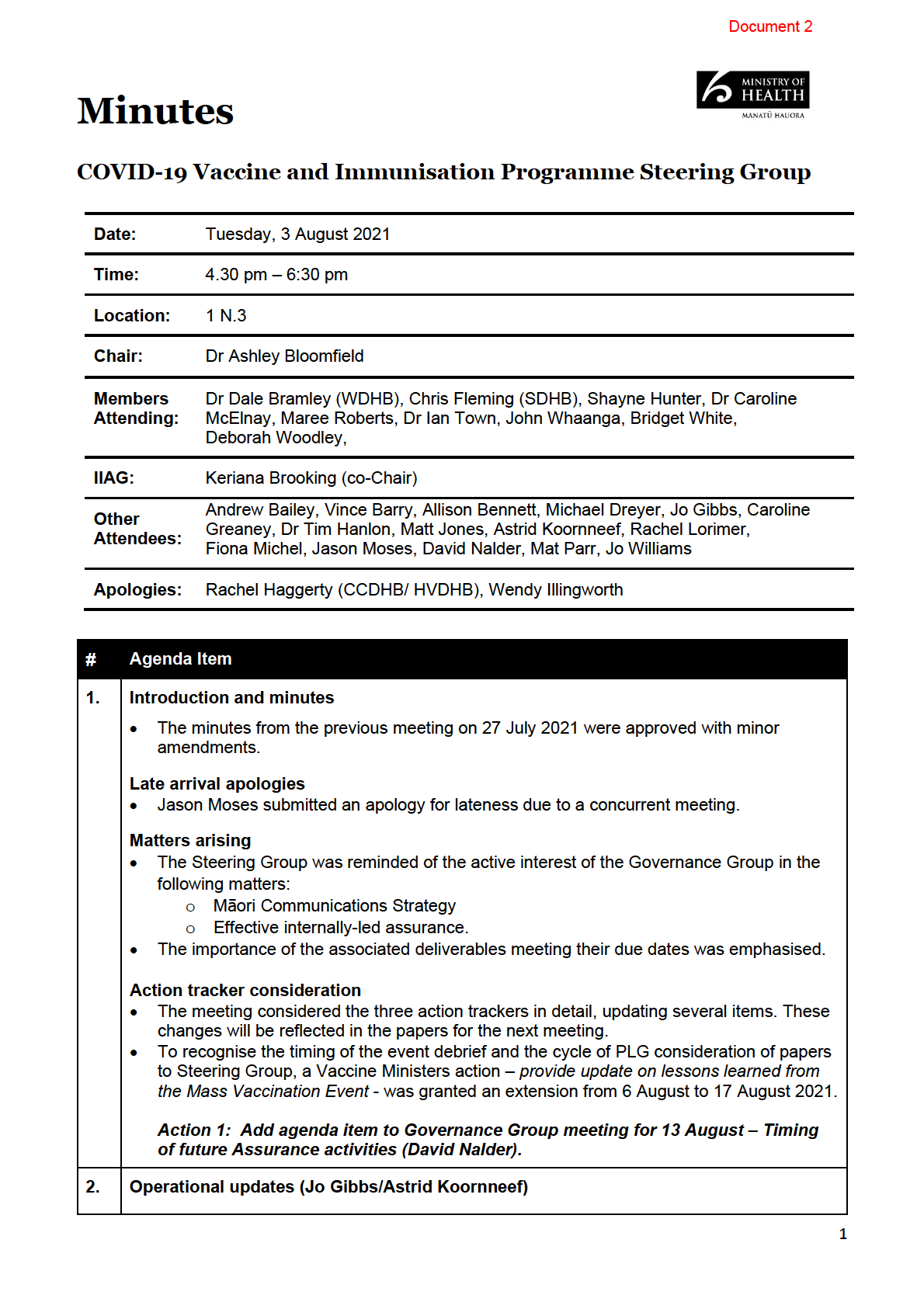
1982
ACT
INFORMATION
OFFICIAL
THE
UNDER
RELEASED
Document 2
2a. Programme Update
Paper 3: COVID-19 Immunisation Programme Update – 1 August 2021
• New Zealand has achieved 2 mil ion vaccinations. Volumes are about 40,000 per day.
• About 25 per cent of the population have had their first dose and about 15 per cent are
fully vaccinated.
• There wil be some ‘tight’ supply points over the next few months. However, currently
supply is not restraining any provider and all are receiving the amounts requested.
2b. Papers 3a and 3b tabled: 65+ yrs Coverage (booked and vaccinated); 60-64 yrs Coverage
(booked and vaccinated)
The tabled papers show the overall numbers of vaccinations booked across DHBs. The data
can be split by DHB, ethnicity and age group.
• Most DHBs are tracking well across older age groups.
1982
• Three DHBs (Southern, Nelson/Marlborough, Lakes) have either completed or
significantly completed vaccinating their populations in the sequenced age groups. To
keep momentum, and avoid unused capacity, the Ministry proposes to seek ministerial
ACT
agreement to allow them to begin vaccinating those in the next age band (55 years and
over) a few days earlier than announcement.
• The Ministry is proactively talking to DHBs needing assistance in reaching some of their
groups of people about proactive campaigns (potentially using Whakarongorau) to assist.
• Noted that the tables do not show primary care.
General discussion
• The charts help to show DHB capacity to deliver. DHBs are variously booked as far out
as November 2021.
INFORMATION
• Noted that DHBs are all bringing on additional resources to ensure they can get up to their
peak delivery.
• Considerations for early age band access by some DHBs include ensuring that an
equitable coverage is maintained for members of this age group in these DHB regions.
• There wil be operational implications if some DHBs are approved to move into
vaccinating the age bands earlier than others. IT changes wil be needed to ensure that
the booking system allows them access; the capaci
OFFICIAL ty of the national call centre wil need
to be checked.
Action 2: The Director-General will discuss early age band access by some DHBs with
THE
Hon Hipkins.
2c. First Mass Vaccination Event (Vince Barry)
• The Ministry worked with the Northern Region Health Co-ordination Centre to hold the first
mass vaccination event 30 July to 1 August, at the Vodafone Events Centre, Manukau.
UNDER
• Total vaccinated - 15,731 people (target 15,500).
• Smooth vaccination and observation processes. St John Ambulance provided
observation services. Positive feedback received from attendees.
• High-quality clinical, draw-up and cold chain processes were maintained at scale, with
clear audit traceability.
• Very low levels of vaccine wastage, and a lower than expected number of adverse events
reported.
RELEASED
• About 15 per cent of bookings did not show; offset by a high number of walk-in bookings.
• Some initial opportunities to streamline processes have been identified. A full debrief will
be held and the Ministry wil update its guidance to DHBs considering mass vaccination
events.
Communication from DPMC
2
Document 2
• The Director-General noted that he had received a communication from the chief
executive of the Department of Prime Minister and Cabinet, congratulating the Ministry on
the successful running of the first mass vaccination event in Auckland.
• The Director-General added his own personal commendation and thanks to all who had
contributed to the success of this event.
Action 3: Report on lessons learned from the mass vaccination event to be considered
by the Steering Group on 17 August.
3.
Science and Technical update (Dr Ian Town)
•
Myocarditis: The CV-TAG wil circulate its advice regarding myocarditis and pericarditis
after vaccination. The advice is precautionary, to the effect that if myocarditis or
pericarditis arise, the person should not receive their second vaccine dose.
1982
•
Use of Pfizer by 12-15 year olds: Neither CV-TAG nor the Strategic COVID-19 Public
Health Advisory Group (chaired by Sir David Skegg) strongly recommend immediate
vaccination of this group. However, young people should be considered if they are ‘at
ACT
risk’ (e.g. because they themselves, or those they live with, are immunosuppressed).
•
Interval between doses: CV-TAG wil provide advice and talking points for the Director-
General about the approaches of other jurisdictions. Noted that internationally, pragmatic
decisions are being made because there is, as yet, no evidence to support decision-
making.
•
Booster vaccination: Advice about booster vaccines will be completed over the next two
or three weeks.
• Co-administration of vaccines: CV-TAG is preparing an update of co-administration of the
COVID-19 vaccine and the influenza and MMR vaccines in the National Immunisation
INFORMATION
Programme.
• CV-TAG is working with the Behavioural Insights Group to develop approaches to
continue to stimulate uptake right across the duration of the programme, including in an
environment of high rates of full vaccination.
General discussion
OFFICIAL
• A question was raised about the use of ‘third dose’ vaccination to improve protection
against COVID-19. There is very lit le evidence to support this. Trials undertaken show
THE
that the antibodies present in a vaccinated person after 12 months were just as high as
they were immediately after vaccination. CV-TAG wil monitor developments.
• Noted that the current priority for New Zealand is to effectively address the risks posed by
the changing virus.
• Noted that, applying an equity lens to uptake by 12-15 year olds, the expert advice was
UNDER
not ‘don’t do it’ but ‘start with these groups’. Agreed that a programme decision wil need
to balance out protection of individuals and concerns about younger people being
‘reservoirs of infection’ (per the current Sydney schools outbreak situation).
• Further consideration wil be given to these issues, noting the interdependencies across
the programme.
4.
Eight week period between vaccinations (Astrid Koornneef)
RELEASED
Verbal update
• There is an emerging view (United Kingdom) that increasing the period of time (i.e. to six
weeks) between the first and second dose wil enhance immunogenicity from COVID-19.
• The Ministry has done early thinking on how this might be implemented in Aotearoa
New Zealand:
3
Document 2
o There are currently 600,000 people who have forward booked their second dose
and consideration needs to be given as to the best way to manage these
bookings. They could be given the option to change, or a change to the booking
system technology could do this automatically and mirror the appointment for six
weeks out.
o New bookings could immediately be forward-booked at six weeks.
o Having a thorough understanding of the ability of DHBs to accommodate these
changes, including forward booking capacity, is critical.
General discussion
• Clear communications wil be essential to retain confidence in the ‘
Book my Vaccine’
system, particularly for those who have already received both doses.
• A bulk move of current second dose bookings wil create spare slots that wil need to be
1982
filled. This could be beneficial in allowing for a significant increase in the number of first
doses delivered, or to provide added flexibility for walk-ins.
• Need to consider the flow-on impacts for DHB production plans.
ACT
• Need to consider the likely impacts on equity. However, it was noted that the delay of the
second dose (particularly a bulk move) would mean that first dose vaccination would
move more quickly into the younger age groups, where Māori are a bigger proportion of
the population than are non-Maori.
• Whānau-based initiatives could be given priority for the newly created spare slots.
• Clinical impacts for individual need to be considered. Some people wil need to maintain
the shorter ‘between dose’ period to align within their clinical care.
• Noted that from a wider clinical perspective it was considered important not to overstate
the U.K. research. However there were no obvious downsides to the approach, noting
INFORMATION
that New Zealand’s three-week period was one of the decisions taken during the initial
pandemic period. It was considered the discussion to be had was more about the
complexity of operationalising.
• DHBs were comfortable with the timeframe extension, but concerned that the longer the
gap between vaccinations, the harder it may be to get people to return if their second
vaccine was no longer ‘top of mind’.
OFFICIAL
• DHBs suggested a preference to give those who already have their second appointment
booked should be able to choose whether to proceed as booked, or to extend the date.
• Impact on DHB operations and the
THE workforce need to be identified.
Decisions of the Steering Group
In relation to the proposal that there should be an eight week period between the first and
UNDER
second COVID-19 vaccination dose, the Steering Group:
a) Noted that there appear to be good reasons why New Zealand should consider
implementing a longer internal between the first and second COVID-19 vaccine
doses; and
b) Noted that written advice on the options to implement a longer interval wil be
provided for consideration by Vaccine Ministers.
RELEASED
4
Document 2
5.
Update – DHB local activities to reach Māori or Pacific peoples (Jason Moses) and
6.
Equity Monitoring Reports (Jason Moses)
Paper 4 – Equity Presentation
• Māori have a significantly younger population composition than do non- Māori. Under the
Sequencing Framework we wil start to see Māori being vaccinated at the same rate as
non-Māori from the 55+ years band (expected to be late August). The Pacific population
has a similar spread.
• Mass event – 7 per cent of attendees were Māori; 12 per cent Pacific people.
• Most Māori providers are vaccinating now, either under contract to DHB or directly.
• DHB vaccination for Pacific people is generally going well (see table page 6) but some
areas need better targeting to lift performance.
• Working with DHBs to identify what they are doing locally to increase their uptake. This
1982
differs by region, but includes marae-based services, festivals, promoting a whānau
approach, in some areas (e.g. rural) promoting a community approach, and promoting
walk-ins.
ACT
• Some disability stakeholders have indicated concerns that people with disabilities should
have been included in Group 2 or Group 3 sequencing. A discussion will be held with
Tātou Whaikaha to make better traction into vaccinating this group. Noted that the
vaccination acceptance rate for people with disabilities is 80 per cent.
General discussion
• Important to ensure that Ministers have visibility of the wide range of actions being taken
to promote vaccination uptake by Māori, nuanced at a local level.
INFORMATION
• Both the community approach and whānau approach capture a wide range of people.
However, the booking system currently does not provide for either. The Ministry is aware
of this and actively looking for ways to support both approaches.
• Noted that while current rates for older Māori and Pacific people are low (as expected
through the sequencing), the tables generally show a better overall vaccination scenario
for these groups than is reflected in public commentary. This data should be published.
• Noted that whilst DHBs had targets, we also need
OFFICIAL to be confident these targets were
appropriate. This means understanding where any given DHB’s targets sit as a proportion
of total Māori or total Pacific in their area, and where they sit compared to other DHBs.
• The story that matters is the propor
THE tion vaccinated, by age band and ethnicity.
• A concern was noted about the use of the HSU as a denominator for reporting
performance, when production plans are based on the Statistics NZ denominator, as this
affects comparability. The Ministry noted that it would work with DHBs to revise their
plans.
UNDER
Decisions of the Steering Group
In relation to paper 4 –
Equity Presentation – dated 2 August 2021, the Steering Group:
a)
Noted that breakdowns of vaccination rates for Māori and Pacific people, and for non-
Māori and non-Pacific people, by age group, wil be published on the Ministry of
Health’s website from about 6 August 2021, and updated on a regular basis.
RELEASED
5
Document 2
7.
Support for people who have had a serious AEFI (Dr Juliet Rumball-Smith, Dr Tim
Hanlon)
Paper 5: Overview of system-level support for consumers who experience serious adverse
events following immunisation – 3 August 2021
• Whilst only a small proportion of consumers who report an adverse event following
immunisation (AEFI) following COVID-19 immunisation report a serious AEFI (around
4%), due to this being a national vaccination programme, this means that the numbers of
consumers reporting a serious AEFI wil stil be significant (currently >350 consumers).
• If this occurs at the vaccination site, initial treatment is managed at the site but may
involve transfer to emergency services for assessment or follow-up from a primary care or
specialist service provider. Consumers may initiate a treatment Injury claim with ACC.
• There is a potential need for a service to support consumers who experience serious
AEFIs to help them navigate the health system and to give them confidence that their
1982
issues have been acknowledged.
• Six options were presented for discussion by the Steering Group.
• Noted that putting additional support in place may also help to increase awareness abou
ACT t
the nature and incidence of serious AEFIs at a health professional and programme level.
Group discussion
• There is an awareness that, certainly in relation to COVID-19 vaccination, affected
consumers want to know that someone in ‘the system’ is aware of and acknowledges their
experience. However, there is no sense that people have wider expectations.
• Current approaches dif er significantly by region. A centralised and consistently applied
response nationally wil better support confidence in the roll-out.
• Noted that this type of support is not typically an action that would be taken by
INFORMATION the Ministry
for an adverse event arising from other treatment. Consideration needs to be given to
wider application. It was also suggested that the fact that COVID-19 vaccination is free
and applies to all New Zealanders may allow for a different approach.
Decisions of the Steering Group OFFICIAL
In relation to paper 5 –
Overview of system-level support for consumers who experience
serious adverse events following immunisation dated 3 August 2021, the Steering Group:
a) Noted the current arrangement
THE s in place at a system level for consumers who
experienced a serious AEFI as a result of COVID-19 vaccination set out in the paper;
b) Agreed that the CVIP would move to implement Option 2 (Extension to Status Quo)
as quickly as possible building to Option 5 (website-based information) and Option 6
(a national follow-up co-ordination pathway) as soon as practicable.
UNDER
8.
Progress against Milestones (Andrew Bailey)
Paper 6: CVIP Schedule Summary Update – 2 August 2021.
• No changes to ‘traffic light’ status over the previous week.
• Payments to some primary care providers are causing concern
(see Item 8a. below).
• Wider system pressures (relating to winter season) have been flagged by DHBs.
RELEASED
8a. Improving Access to Vaccination - Primary Care (Dr Joe Bourne/Astrid Koornneef)
Paper 7: Vaccination Sites – Onboarding – 2 August 2021
• Currently have 361 active primary care sites, of which 113 are pharmacies, 118 are
medical centres, and 30 are marae-based or Hauora providers.
• 89 sites onboarded in the week to 30 July 2021.
6
Document 2
• Working with DHBs to understand how they are onboarding primary care over the next
few months. Potentially will use a bigger cohort of primary care providers to get to scale.
• The programme is getting very good engagement from DHBs. Noted that DHBs are also
providing a lot of support to each other.
• Key approach dif erences relate to the ability of the smaller DHBs to cope with the extra
workload.
• It is important to ensure that DHBs have in place the appropriate contracts with their
primary care providers so that these providers can receive funding without delay. The
Ministry has written to CFOs of all DHBs to remind them of this.
Action 4: Add ‘Primary Care Roll-out’ to the agenda for the Steering Group meeting on
10 August.
8b. Communications and Engagement (Rachel Lorimer)
1982
Paper 8: Communications and engagement support for COVID-19 vaccine rollout - 2 August • Significant achievements in the past week include:
o Second vaccination of the Prime Minister;
ACT
o Arrival of the first vaccine shipment into the South Island hub;
o Vaccination roll-out in Stewart Island;
o Launch of the 0800 number for people in Group 3;
o Medsafe approval of AstraZeneca for New Zealand.
• The Ministry is now doing daily reporting of numbers vaccinated.
• Focus groups are being held for those aged 60+ yrs. Noted their feedback doesn’t quite
match with the wider research report, in that the focus group members respond well to
current campaign approach. This wil be considered further.
• Consideration being given to how the ‘good news stories’ can be used in public
INFORMATION
communications.
9.
Any other business
Vaccinator status (Fiona Michel)
• Total vaccinators for COVID-19 now over 10,000. Over 2,000 of these are enrolled
OFFICIAL
vaccinators, most of whom are Māori.
• Good progress has been made with processing the approximately 400 vaccinators who
had applied for authorisation at the time the authorisation function was being transferred
THE
back to the Ministry. Most of these are now authorised.
The meeting closed at 6.30 p.m.
10. Next Meeting UNDER
Tuesday 10 August 2021, 4.30 p.m. – 6.00 p.m.
RELEASED
7

1982
ACT
INFORMATION
OFFICIAL
THE
UNDER
RELEASED
Document 2
• Anticipate that New Zealand wil have a mil ion fully vaccinated people in the week
commencing 9 August.
• Focus on developing guidance on the changes to the interval between doses.
• Good data being received through the portal. We have a good system overview of stock
in hand and supplies.
Age banding
• DHBs raised a concern that there was unused vaccination capacity in the regions
because of the age banding constraints. This would become more pronounced with the
longer interval between doses. DHBs are very keen to continue to vaccinate to their
capacity.
• Noted that the next age band announcement was likely to be made a little earlier than
originally planned and there was an expectation that age band restrictions may free up
significantly in the foreseeable future.
• Different DHBs are at dif erent stages. Some of the larger DHBs have solid forward
1982
bookings, but some of the smaller DHBs are receiving support (e.g. outwards calling) to
fil their booking spaces.
• Some regions endeavouring to focus on whānau bookings are encountering some i
ACT ssues
with the booking system. The Ministry advised this is something they are aware of and
are looking to identify a solution for.
2b.
COVID-19 Vaccine Independent Safety Monitoring Board (CV-ISMB) (Dr Tim Hanlon)
Verbal update
• The CV-ISMB met to consider the death of a s 9(2)(a) consumer a few days after first dose
vaccination and with a cause of death on post-mortem given as myocarditis. Noted that
this case also had s 9(2)(a)
.
INFORMATION
• The forensic pathologist who conducted the post-mortem presented his findings to the
board.
• The board will now write to the Director-General and CVIP National Director outlining its
views and any suggested actions for CVIP.
• Some changes to communications to the sector about early detection and treatment of
post-vaccination myocarditis are likely.
OFFICIAL
• The Ministry confirmed it is providing support to s 9(2)(a) of this consumer.
Group discussion
THE
• The regulator noted that Medsafe wil consider the recommendations from the Board and
assess their implications for the content of its Pfizer/Comirnaty safety alert.
3.
Update from Immunisation Implementation Advisory Group meeting – 5 August 2021
UNDER
(Caroline Greaney)
Key areas of focus and discussion were:
• IIAG value proposition: members need to feel that they both add value to COVID-19
vaccination implementation planning and receive value back. Many members are
directly involved in service provision and need to be satisfied that their significant time
allocation to IIAG is justified.
RELEASED
• Commissioning: national consistency for service procurement is essential, particularly as
increasing numbers of primary care providers come on board the programme. Members
continue to have some concerns about funding adequacy and funding flows, and would
like to see if the Ministry can promote more consistency in how DHBs apply their ‘special
needs’ funding. The possibility of a rural adjustor was flagged.
• Achieving equity: under IIAG Terms of Reference, members have a strong ongoing
interest in equity performance and noted the recent move to use Heath Service
Utilisation (HSU) data as a denominator for future reporting. They reinforced the need to
2
Document 2
ensure that reporting across the wider programme was comparable. (The Ministry
confirmed it would work with DHBs to adjust their plans.)
• Vaccination for 12-15 year olds – IIAG input included the subsequent comms and
engagement challenges that would arise because of the multiple prioritised groups, the
interface of this age cohort with other immunisation programmes, the need for a consent
process, DHB capability and capacity to incorporate this group into production plans, and
the need to consider equity impacts.
4.
Reporting against the Success Framework (Luke Fieldes, Astrid Koornneef)
Paper 4: CVIP Outcome Measures – Status update – 10 August 2021
• At a high level this reporting shows that we are making good progress with a notable
increase in uptake dose 1 uptake by those aged 60-64 since 28 July 2021 (rol -out date).
For Group 3, there is significantly higher uptake by people with at least one long term
1982
condition (LTC) than by those without an LTC. Average waiting times have reduced over
the previous week. High vaccine usage rate.
ACT
• Group 3 faces issues relating to uptake by Māori, irrespective of sequencing.
• Noted that Māori, Pacific and Asian groups have a larger proportion of bookings for
younger age groups. Other groups are more heavily represented within the older age
groups. This is not necessarily unexpected as it coincides with the shape of population
distribution.
Group discussion
• Noted that efficiency measures stil show performance above plan, however, the plan
does not move forwards in equal increments and this can impact on deliver
INFORMATION y.
• Observed that there are a reasonable number of 40-50 year olds in forward bookings
who have qualified outside of age banding.
• Geospatial work is under way to consider factors influencing attendance at vaccination
sites and to help with future modelling. Considerations include population density in the
area within a 30 minute drive time of the site, vehicle ownership, and public transport
availability.
OFFICIAL
5.
Readiness for extending vaccination to 12-15 year olds (Jo Gibbs)
THE
Verbal update
• This matter is under active consideration. Cabinet wil consider advice on options to
extend the Pfizer vaccine to 12-15 year olds on 16 August.
UNDER
• A small team has been set up inhouse to consider the implementation approach.
6.
Māori, Pacific Peoples and Disability communications (Rachel Lorimer)
Paper 5: Communications Update: Mā
ori, Pacific and Disability – 10 August 2021
Papers 6 and 6a: CVIP – Mā
ori Communications Strategy
RELEASED
• The Governance Group has noted its strong focus in being assured that the programme
has in place a Māori Communications Strategy to support achievement of the CVIP
equity objectives.
• The Ministry has allocated funding for engagement with communities to help to remove
barriers to uptake of vaccination services. This activity sits alongside ‘mainstream’ media
promotion.
• Minister Henare has a clear interest in understanding how a communications plan
supports funding allocations to achieve the desired outcomes for Māori.
3
Document 2
• The Ministry is working with the Cause Collective to help to engage with Pacific
communities.
• A meeting has been held with Hon Carmel Sepuloni regarding engagement with disability
communities.
General discussion
• Noted that in addition to the broader strategy, the Governance Group was also very
interested in what was happening at a local level to increase uptake.
• Members noted that the draft documents contained strong context, drivers of behaviour,
and risk assessment. Noting the Governance Group’s focus, some strengthening of
actual approaches (at the back of the paper) was needed.
Decisions of the Steering Group
1982
In relation to paper 5 ‘
Communications Update: Mā
ori, Pacific and Disability’ and papers 6
and 6a ‘
CVIP – Mā
ori Communications Strategy’ the Steering Group:
ACT
a)
Noted the programme of work set out in paper 5 that is being undertaken by the
CVIP Programme to facilitate communications and engagement for Māori, Pacific and
Disabled Populations, and
b)
Requested that paper 6 and 6a be strengthened to include more detail on the actual
approaches that are to be used in the regions to help to support the roll-out of
COVID-19 vaccinations for Māori.
7.
Contingency planning for workforce during Alert Levels 3 and 4 (Fiona Michel)
Paper 7: Contingency planning for workforce during Alert Levels 3 and 4 – disc
INFORMATION
ussion paper,
10 August 2021
• This discussion paper sought guidance on the focus for policy development for
contingency planning to ensure the vaccination workforce had the capacity to meet the
likely expected increased demand for vaccination during higher alert levels.
• Current vaccination workforce about 10,000 though not all are full time.
OFFICIAL
• Four options are outlined:
o option 1 – Using Defence Force personnel;
o option 2 – reprioritising DHB workforce;
THE
o option 3 – contracting a ‘reserve’ vaccination team that can be deployed into
affected regions;
o option 4 – Activating mass vaccination, primary care and drive through models
(noting this was an implementation approach rather than being directly a
workforce issue).
UNDER
Group discussion
• Noted that at Alert Level 3 and 4 were quite likely to be applied at a regional rather than
national level.
• Option 1 was not considered a strong option given NZDF was already fully engaged in
running managed isolation facilities and associated activities.
• Option 2 w
RELEASED as noted as a stronger option for summer, when the health workforce was not
already stretched covering winter il ness cases. However, consideration should be given
to extending the scope of those included e.g. surgeons and highly trained clinicians could
be given prior training as their services all but stopped during AL4. Also consider plunket
nurses and other nurse-based services.
• The need to protect the workforce who would otherwise be required during a high alert
level was noted.
• Noted that this work was an extension of DHB resurgence planning.
4
Document 2
Decisions of the Steering Group
In relation to paper
7: Contingency planning for workforce during Alert Levels 3 and 4 –
discussion paper, the Steering Group:
a) Did not agree to further explore Option 1, noting that the demands on the NZDF
workforce are ongoing;
b) Agreed that the Option 2 should be developed to include consideration of how other
health service providers who are unlikely to be utilised during high alert levels (e.g.
specialists, surgeons, highly trained clinicians, plunket nurses and other nurse-
based services) can be redeployed into vaccination during Alert Levels 3 and 4;
c) Agreed to retain and further develop Option 3, noting this appeared to be more of a
reallocation of the current workforce;
d) Agreed to retain and further develop Option 4, noting this was a service delivery
mechanism; and
e) Noted it would receive an updated paper with detailed policy options and
1982
recommendations in early September 2021.
•
Action 1: Prepare a paper with detailed policy analysis and recommendations, for
consideration by the Steering Group on 7 September 2021. [Fiona Michel]
ACT
8.
Amendments to Medicines Regulations 1984
Paper 8: Amendments to Medicines Regulations 1984, Schedule 1
• The issues in this paper were outlined and discussed. It was noted that decisions on this
matter had implications for service delivery more widely than COVID-19 vaccination. It
was decided that this paper would be further considered and decisions taken outside of
the Steering Group.
INFORMATION
9.
Risk Update (David Nalder)
Paper 9 – CVIP Programme risk summary for Steering Group – 10 August 2021
• The Programme Leadership Group (PLG) continues to review programme risks every
fortnight. Current risks relate to delivering to scale, and achieving uptake, with a focus
OFFICIAL
on equitable uptake.
• A new risk is added to the high level ‘Experience’ category risk, being ‘public apathy’.
This would impact on uptake.
THE
• Specific issues to note are the operational implications of any move to change the time
between doses where a broad range of issues wil need to be considered. These include
communications managed, the impact on invitations and bookings, inventory
management and digital enablement.
UNDER
Decisions of the Steering Group
In relation to paper 9
: CVIP Programme risk summary for Steering Group, the Steering
Group: •
Noted the map of inherent risks across the end-to-end vaccination process design; and
•
Noted the actions in place to manage these risks.
RELEASED
5
Document 2
10. Progress against Milestones (Andrew Bailey)
Paper 10: CVIP Schedule Summary Update – 9 August 2021
10a. Improving access to vaccination – primary care roll-out (Astrid Koornneef)
Verbal update
• Currently have 386 active primary care sites (up from 361 last week), including
pharmacies, medical centres, and marae-based or Hauora providers.
• 43 sites onboarded in the week to 8 August (89 in the week to 30 July 2021).
• Noted that the Royal New Zealand College of General Practitioners sets accreditation
standards for general practice. It believes its Foundation Standard aligns with most of
the Covid Vaccine Immunisation Programme Standards. The College is writing to all
DHBs setting out where there is alignment and where there are gaps. The aim is to
provide a degree of assurance to DHBs so that they can reduce the administrative 1982
burden of some of the onboarding process for general practice. However, we are
ensuring that DHBs are aware that ensuring services are delivered to an appropriate
quality remains their responsibility.
ACT
10b. Workplace vaccinations update (Rachel Mackay)
Verbal update
• EOI for workplace vaccination closed 23 July with 330 responses, primarily from
workplaces across a range of sectors. Some interest from service providers.
• Immediate response process on:
o workplaces with over 1,000 workers
o smaller workplaces that have a strong focus on Māori, Pacific, disability, or rural
INFORMATION
groups.
• The two pilot employers (Mainfreight, Fonterra) wil both have completed their first round
by 11 August. The Ministry wil debrief with both on the learnings from these pilots.
• Engagement under way with the supermarket sector, as essential service providers.
Noted that the Minister wil be addressing groups on this and the Ministry has provided
talking points.
OFFICIAL
• Also working with the Public Service Commission on government agency workplace
vaccination planning. THE
11. Any other business
The following papers were noted:
• Paper 11 - Update: Communications and engagement support for COVID-019 vaccine
rollout.
UNDER
• The meeting closed at 6.00 p.m.
12. Next Meeting
Tuesday 17 August 2021, 4.30 p.m. – 6.00 p.m.
RELEASED
6
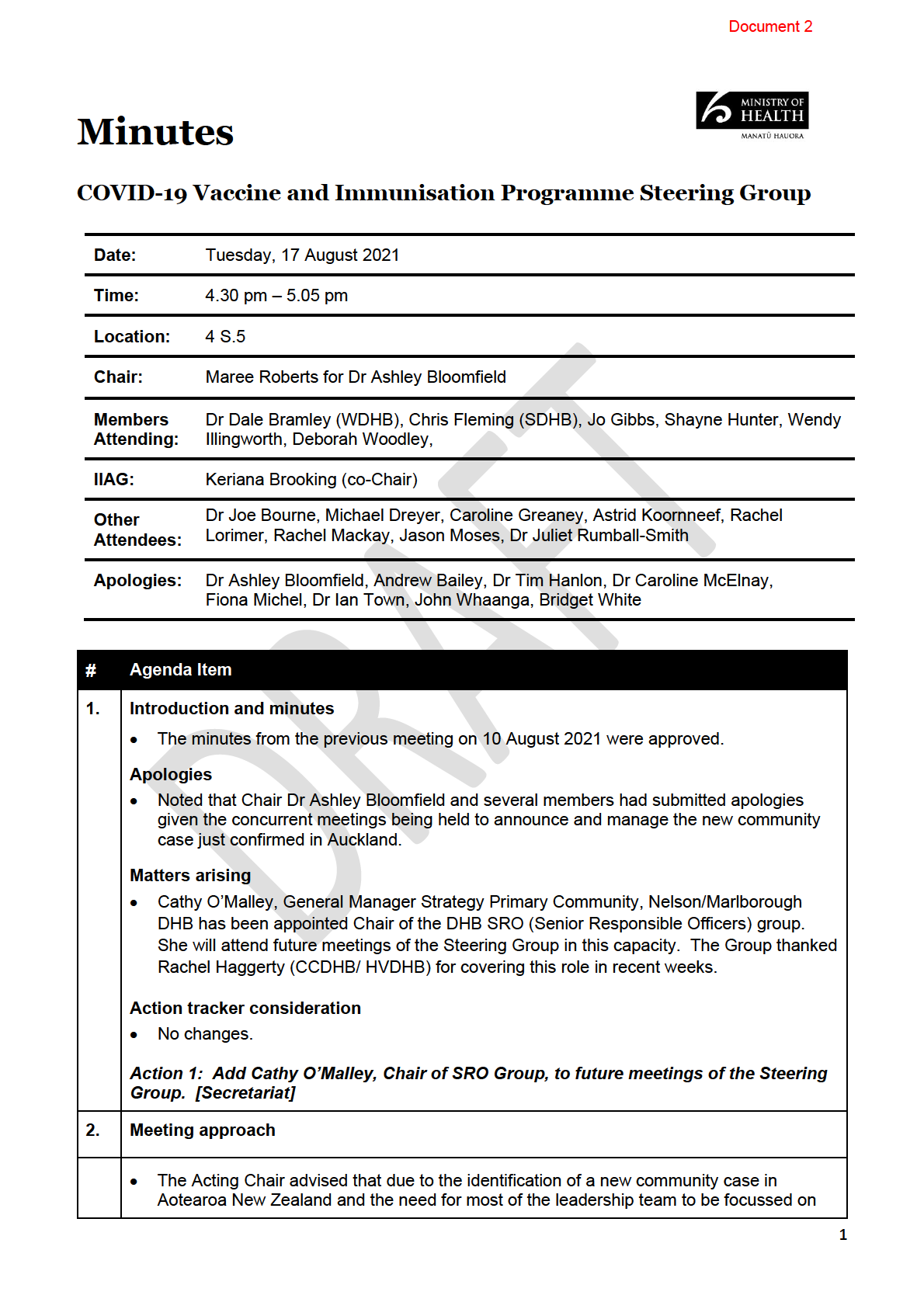
1982
ACT
INFORMATION
OFFICIAL
THE
UNDER
RELEASED

1982
ACT
INFORMATION
OFFICIAL
THE
UNDER
RELEASED
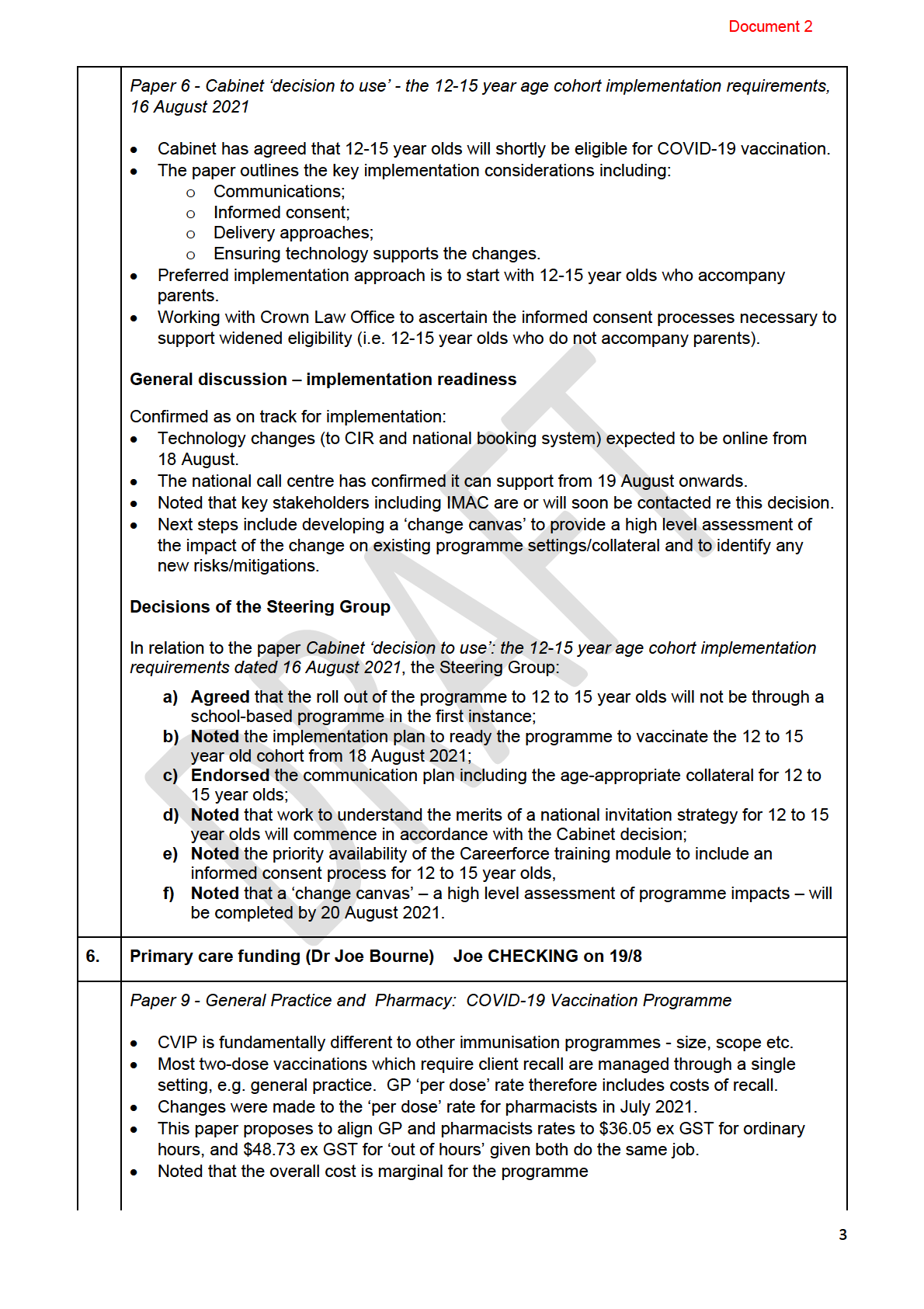
1982
ACT
INFORMATION
OFFICIAL
THE
UNDER
RELEASED

1982
ACT
INFORMATION
OFFICIAL
THE
UNDER
RELEASED
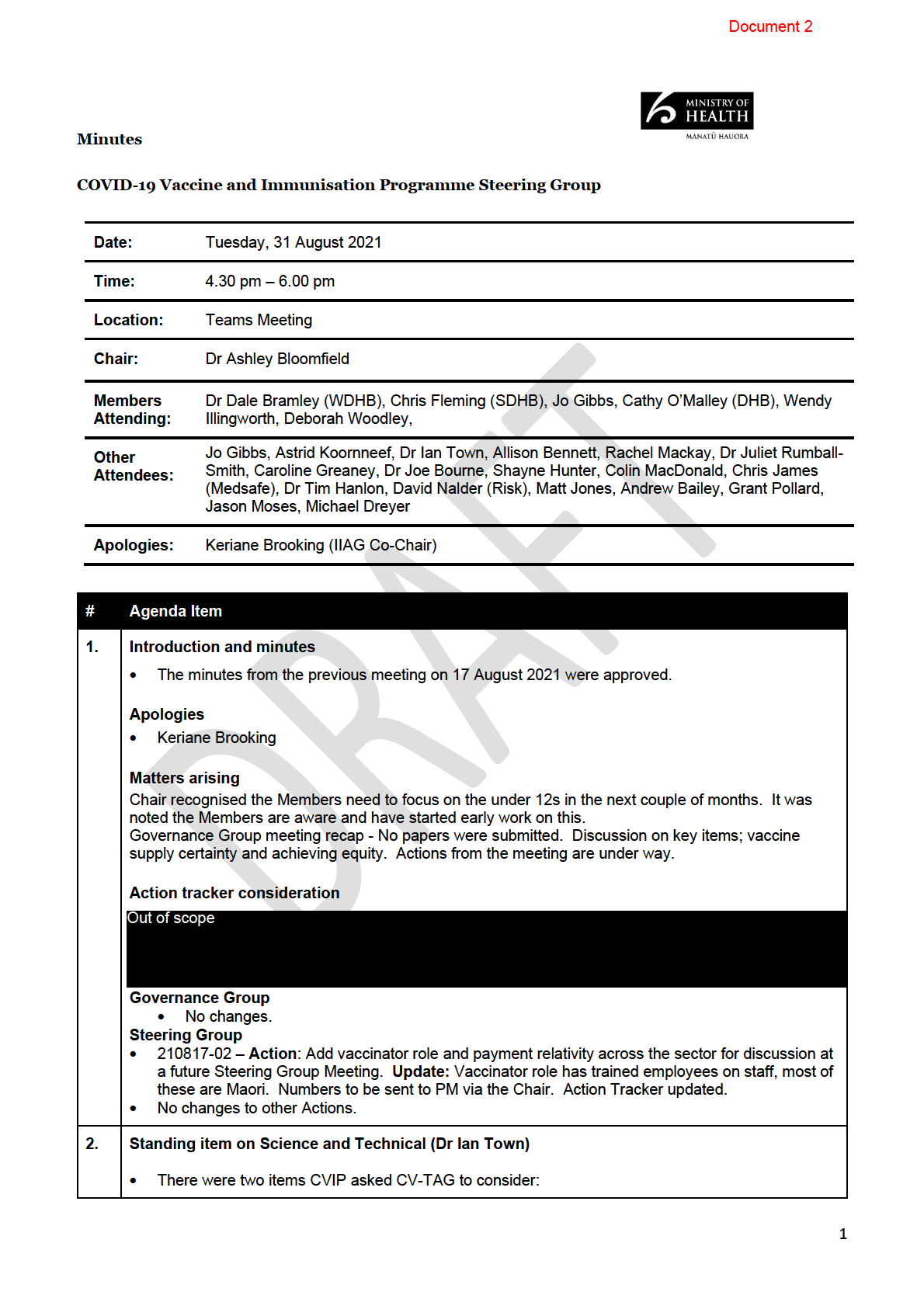
1982
ACT
INFORMATION
OFFICIAL
THE
UNDER
RELEASED
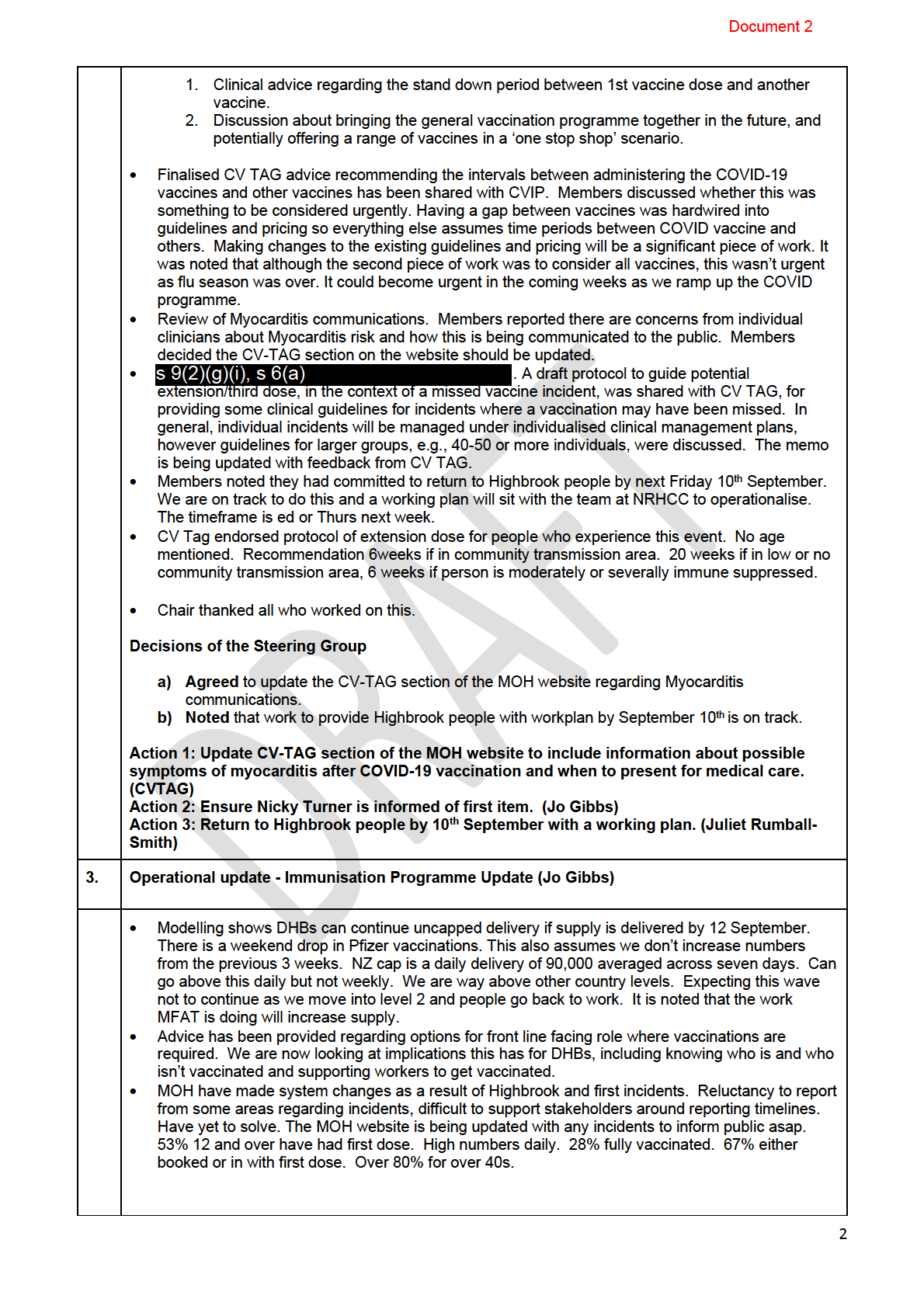
1982
ACT
INFORMATION
OFFICIAL
THE
UNDER
RELEASED
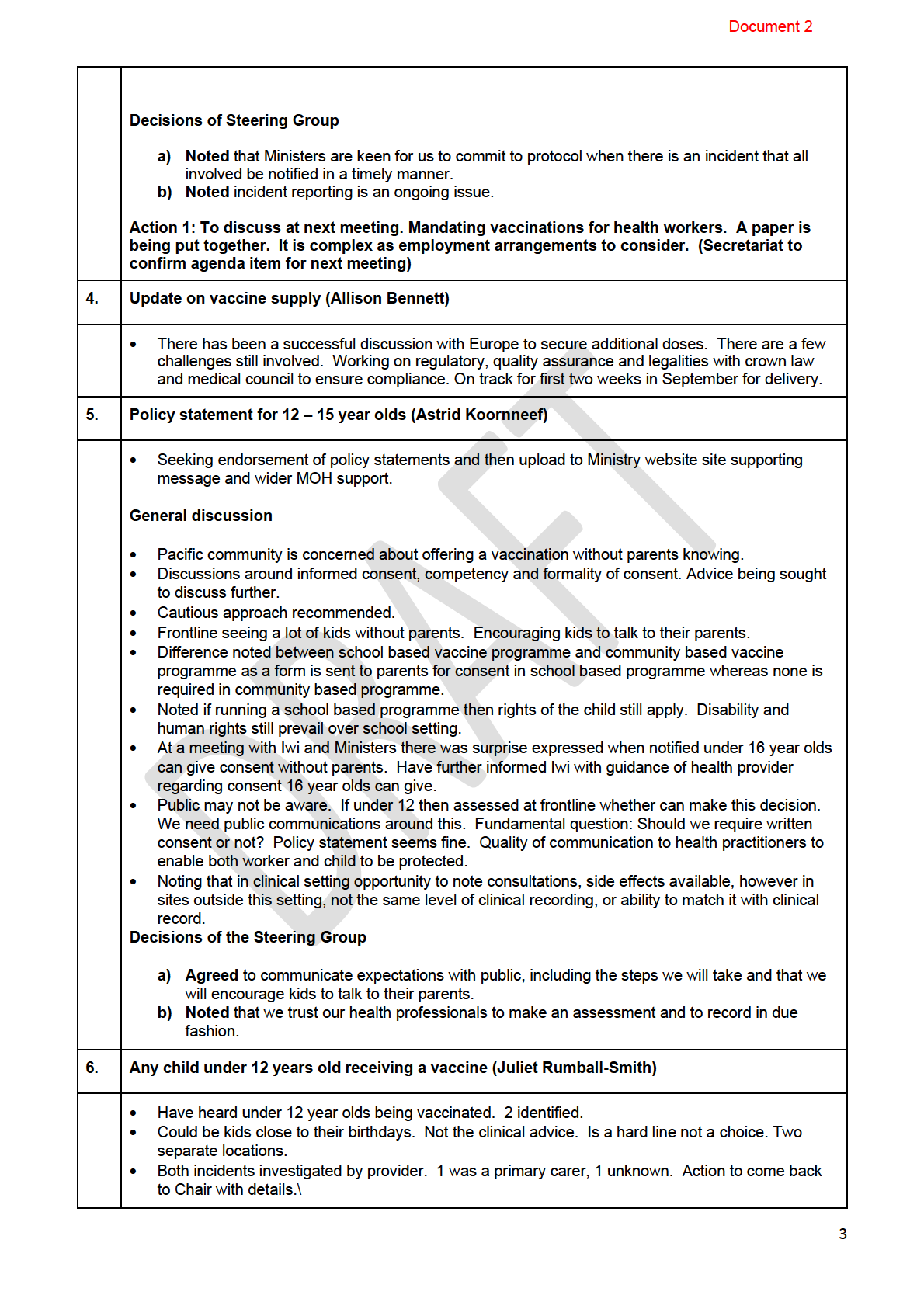
1982
ACT
INFORMATION
OFFICIAL
THE
UNDER
RELEASED

1982
ACT
INFORMATION
OFFICIAL
THE
UNDER
RELEASED

1982
ACT
INFORMATION
OFFICIAL
THE
UNDER
RELEASED

















